|
|
|
|
|
Oil On
Canvas, Real Flavor of Old Masters
|
|

|
ARTWORKS
INDEX
A B C D E F G H I J K L M N O P Q R S T U V W X Y Z |
ARTISTS
INDEX
A B C D E F G H I J K L M N O P Q R S T U V W X Y Z |
|
|
| | |
|
|
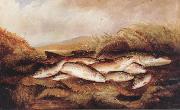 |
Henry Leonidas Rolfe -- Click Here
|
|
British,active 1847-81 |
|
|
|
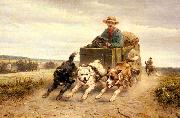 |
Henriette Ronner-Knip -- Click Here
|
|
was a Dutch painter.
Born Henriëtte Knip in Amsterdam, she moved at a young age to Den Bosch and was until 1850 active in Sint-Michielsgestel and Boxtel. That year she married Feico Ronner and moved to Belgium, first to Brussels and in 1878 to Elsene. She studied with her father, Joseph August Knip.
She was best known for her paintings of subjects from nature, especially cats and dogs.
|
|
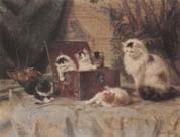 |
Henriette Ronner -- Click Here
|
|
French
1821-1909
He was a Dutch painter. Born Henriette Knip in Amsterdam, she moved at a young age to Den Bosch and was until 1850 active in Sint-Michielsgestel and Boxtel. That year she married Feico Ronner and moved to Belgium, first to Brussels and in 1878 to Elsene. She was best known for her paintings of subjects from nature, especially cats and dogs. |
|
|
|
 |
Henrietta Rae -- Click Here
|
|
(30 December 1859 - 26 January 1928) was a prominent English painter of the later Victorian era.
Born in Hammersmith, London, she was the youngest of seven children of a civil servant; her mother was musically talented, a former student of Felix Mendelssohn. An uncle, Charles Rae, was an artist and a student of George Cruikshank. Rae began studying art at age thirteen; she was educated at the Queen Square School of Art, Heatherley's School of Art (she was its first female pupil), and the British Museum. She reportedly had to apply to the Royal Academy schools at least five times before she was accepted though she eventually gained a seven-year scholarship. Her teachers there included Frank Bernard Dicksee, William Powell Frith, and Sir Lawrence Alma-Tadema; the last of these had the strongest influence on Rae's later work. She became a frequent exhibitor at the annual Royal Academy shows, beginning in 1881.
She gained recognition and success early in her career, specializing in classical, allegorical, and literary subjects, often treated in a grand style and scale; her Psyche at the Throne of Venus (1894) measured 12 feet by 7 feet (305 by 193 cm) and contained 13 figures. Other paintings in the same classical vein include her Ariadne (1885), Eurydice (1886), Zephyrus and Flora (1888), Apollo and Daphne (1895), Diana and Calisto (1899), and Hylas and the Water Nymphs (1910) among many more. |
|
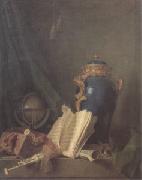 |
Henri-Horace Roland de La Porte -- Click Here
|
|
Paris 1724-1793
French painter. He was a pupil of Jean-Baptiste Oudry and was approved by the Academie Royale de Peinture et de Sculpture in 1761 as a 'painter of animals and fruit'. He presented his morceau de reception, the ambitious Vase of Lapis, Ornamented with Bronze and Placed near a Globe (Paris, Louvre), in 1763. This large painting is reminiscent of Oudry's work and depicts a collection of sumptuous objects against a simple cloth backdrop. Roland de la Porte's later works are much more intimate in scale and approach and depict simple rustic objects in a restrained yet realistic fashion in a manner akin to Chardin, for whose works his own have been mistaken. The Still-life with Bread and Fruit (Rotterdam, Boymans-van Beuningen) is bathed in a warm light; the composition is unusual in that the bread, plums and preserve pot are represented at the viewer's eye level, obscuring the top of the table. The Little Orange Tree (Karlsruhe, Staatl. Ksthalle) uses several devices similar to those used by Chardin: a light source comes from the upper left-hand side, throwing some of the surfaces into relief and highlighting them against the indistinct background; a single straw is brought into focus and seems to protrude out of the picture |
|
|
|
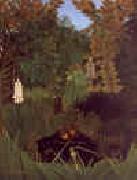 |
Henri Rousseau -- Click Here
|
|
French
1844-1910
Henri Rousseau Locations
He was born in Laval in the Loire Valley into the family of a plumber. He attended Laval High School as a day student and then as a boarder, after his father became a debtor and his parents had to leave the town upon the seizure of their house. He was mediocre in some subjects at the high school but won prizes for drawing and music. He worked for a lawyer and studied law, but "attempted a small perjury and sought refuge in the army," serving for four years, starting in 1863. With his father's death, Rousseau moved to Paris in 1868 to support his widowed mother as a government employee. In 1871, he was promoted to the toll collector's office in Paris as a tax collector. He started painting seriously in his early forties, and by age 49 he retired from his job to work on his art. His wife died in 1888 and he later remarried.
Rousseau claimed he had "no teacher other than nature", although he admitted he had received "some advice" from two established Academic painters, Felix Auguste-Clement and Jean-Leon Gerome. Essentially he was self-taught and is considered to be a naive or primitive painter. |
|
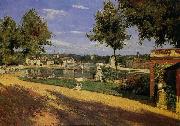 |
Henri Rouart -- Click Here
|
|
France (1833 -1912 ) - Painter
|
|
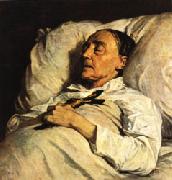 |
Henri Regnault -- Click Here
|
|
Paris 1843 - Buzenval 1871.
French Academic Painter, 1843-1871. Studied under Alexandre Cabanel. Specializes in Orientalism. Painter, son of Victor Regnault. He showed exceptional abilities as a draughtsman from an early age. After a traditional classical education he was sent in 1860 to the Ecole des Beaux-Arts, Paris, where he studied with Louis Lamothe (1822-69) and Alexandre Cabanel. In 1866 he won the Prix de Rome competition with Thetis Giving the Weapons of Vulcan to Achilles (Paris, Ecole N. Sup. B.-A.). In Italy he began several other ambitious history paintings, including Automedon Taming the Horses of Achilles |
|
|
|
|
|
Helen Allingham,R,W.S -- Click Here
|
|
1848-1926
Studies of Flowers
Studies of Flowers .was a well-known watercolour painter and illustrator of the Victorian era. Helen Mary Elizabeth Paterson was born in Swadlincote in Derbyshire,[1] England. Her sister and her father, a doctor, died of diphtheria in 1862, and the rest of the family went to live in Birmingham. In 1867 she went to study art at the "Female School of Art", a section of what became the Royal College of Art in London, and became an illustrator of children's books. She was a great friend of Kate Greenaway. On 22 August 1874, she married William Allingham, who was almost twice her age. At the time, she was employed in illustrating some of the novels of Thomas Hardy, and they were attracted to one another when they met. Helen Allingham illustrated several books, including Six to sixteen: a story for girls (1876), Happy England (1903) and The homes of Tennyson (1905), written with her brother Arthur Paterson. After her marriage to Allingham, she became a watercolour painter, and she was the first woman to become a full member of the Royal Watercolour Society. As well as landscapes, she completed several portraits, including one of Thomas Carlyle. |
|
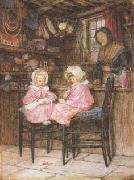 |
Helel Allingham,RWS -- Click Here
|
|
1848-1926
was a well-known watercolour painter and illustrator of the Victorian era. Helen Mary Elizabeth Paterson was born in Swadlincote in Derbyshire,[1] England. Her sister and her father, a doctor, died of diphtheria in 1862, and the rest of the family went to live in Birmingham. In 1867 she went to study art at the "Female School of Art", a section of what became the Royal College of Art in London, and became an illustrator of children's books. She was a great friend of Kate Greenaway. On 22 August 1874, she married William Allingham, who was almost twice her age. At the time, she was employed in illustrating some of the novels of Thomas Hardy, and they were attracted to one another when they met. Helen Allingham illustrated several books, including Six to sixteen: a story for girls (1876), Happy England (1903) and The homes of Tennyson (1905), written with her brother Arthur Paterson. After her marriage to Allingham, she became a watercolour painter, and she was the first woman to become a full member of the Royal Watercolour Society. |
|
 |
Hans Rottenhammer -- Click Here
|
|
German Painter, ca.1564-1626 |
|
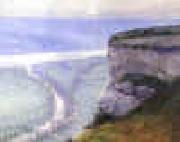 |
Guy Rose -- Click Here
|
|
1867-1925
Guy Rose Galleries
Guy Rose (3 March 1867?C17 November 1925) was an American Impressionist painter who is recognized as one of California's top impressionist painters of the late 19th and early 20th centuries.
Guy Orlando Rose was born March 3, 1867 in San Gabriel, California. He was the seventh child of Leonard John Rose and Amanda Jones Rose.
His father was a prominent California senator. He and his wife raised their large family on an expansive Southern California ranch and vineyard?? the San Gabriel Valley town of Rosemead bears the family name. In 1876 young Guy Rose was accidentally shot in the face during a hunting trip with his brothers. While recuperating he began to sketch and use watercolors and oil paints. He graduated from Los Angeles High School in 1884 and moved to San Francisco where he did his art training at the California School of Design.
In September 12, 1888, Rose enrolled at the Academie Julian in Paris and studied with Benjamin-Constant, Jules Lefebvre, Lucien Doucet and Jean-Paul Laurens while in Paris. In 1888-89, he won a scholarship at the Academie Delacluse. He met fellow students Frank Vincent and Frederick Melville at the Academie Julian -- Frank Vincent and Guy Rose were to remain lifelong friends.
Rose lived New York, New York in the 1890s and illustrated for "Harper's," "Scribners," and "Century". Choosing to return to France in 1899, he and his wife Ethel Rose bought a cottage at Giverny. In 1900 he resided in Paris and spent the winter in Briska, Algeria where he painted three known paintings. From 1904 to 1912 husband and wife lived in Giverny and his works from this period show the influence of "the master" Claude Monet, who became his friend and mentor.
In 1913-1914 the Roses summered in and held an outdoor sketching school at Narragansett, Rhode Island. Suffering on and off again from the effects of lead poisoning, Rose and his wife moved permanently to Los Angeles, California in 1914.
In Los Angeles, Guy Rose taught and served as Director of the Stickney Memorial School of Art in Pasadena. In 1921 he suffered a debilitating stroke that left him paralyzed. Guy Rose died in Pasadena, California on November 17, 1925. In 1926 the Stendahl Gallery held a memorial exhibition of his works. |
|
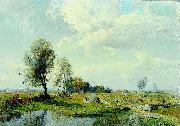 |
Gustaf Rydberg -- Click Here
|
|
painted Skansk slatt med pilvall - motiv fran Viby in 1923
Swedish, 1835-1933 |
|
 |
Guido Reni -- Click Here
|
|
1575-1642
Italian
Guido Reni Galleries
Born in Bologna into a family of musicians, Guido Reni was the son of Daniele Reni and Ginevra de?? Pozzi. As a child of nine, he was apprenticed under the Bolognese studio of Denis Calvaert. Soon after, he was joined in that studio by Albani and Domenichino. He may also have trained with a painter by the name of Ferrantini. When Reni was about twenty years old, the three Calvaert pupils migrated to the rising rival studio, named Accademia degli Incamminati (Academy of the "newly embarked", or progressives), led by Lodovico Carracci. They went on to form the nucleus of a prolific and successful school of Bolognese painters who followed Annibale Carracci to Rome. Like many other Bolognese painters, Reni's painting was thematic and eclectic in style.
By late 1601, Reni and Albani had moved to Rome to work with the teams led by Annibale Carracci in fresco decoration of the Farnese Palace. During 1601-1604, his main patron was cardinal Sfondrato. By 1604-1605, he received an independent commission for an altarpiece of the Crucifixion of St. Peter. After a few year sojourn in Bologna, he returned to Rome to become one of the premier painters during the papacy of Paul V (Borghese). From 1607-1614, he was one of the painters patronized by Borghese.
Abduction of Deianira, 1620-1621.Reni's frescoed ceiling of the large central hall of garden palace, Casino dell'Aurora located in the grounds of the Palazzo Pallavicini-Rospigliosi, is considered his masterpiece. The casino was originally a pavilion commissioned by Cardinal Scipione Borghese; the rear portion overlooks the Piazza Montecavallo and Palazzo del Quirinale. The massive fresco is framed in quadri riportati and depicts Apollo in his Chariot preceded by Dawn (Aurora) bringing light to the world. The work is restrained in classicism, copying poses from Roman Sarcophagi, and showing far more simplicity and restraint than Carracci's riotous Triumph of Bacchus and Ariadne[5] in the Farnese. Reni in this painting is allies himself more with the sterner Cavaliere d'Arpino,Lanfranco, and Albani "School" of mytho-historic painting, and less with the more crowded frescoes characteristic of Pietro da Cortona. There is little concession to perspective, and the vibrantly colored style is antithetical to the tenebrism of Caravaggio's followers. Payments showed that he was paid in 247 scudi and 54 baiocchi upon completion on 24 September 1616.
He also frescoed in Paoline Chapel of Santa Maria Maggiore in Rome as well as the Aldobrandini wings of the Vatican. According to rumor, the pontifical chapel of Montecavallo (Chapel of the Annuciation) was assigned to Reni to paint. However, because he felt underpaid by the ministers, the artist left for Bologna, leaving the role of the preeminent artist in Rome to Domenichino. |
|
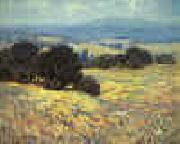 |
Granville Redmond -- Click Here
|
|
1871-1935
Granville attended the Berkeley School for the Deaf (later the California School for the Deaf) from 1879 to 1890 where his artistic talents were recognized and encouraged. There his teacher Theophilus d'Estrella taught him painting, drawing and pantomime.
When he graduated from CSD, Redmond enrolled at another CSD: the California School of Design in San Francisco, where he worked for three years with teachers such as Arthur Matthews and Amedee Joullion. He famously won the W. E. Brown Medal of Excellence. He associated with many other artists, including Gottardo Piazzoni and Giuseppe Cadenasso. Piazzoni learned American Sign Language and he and Redmond were lifelong friends. They lived together in Parkfield, California, and Tiburon.
1893 saw Redmond win a scholarship from California School of the Deaf and from the School of Design, which made it possible for him to study in Paris at the Academie Julian under teachers Jean-Paul Laurens and Benjamin Constant. At the Academie Julian, he roomed with sculptor Douglas Tilden, famous deaf sculptor and another graduate of the California School for the Deaf. In 1895 in Paris his painting Matin d'Hiver, was accepted for the Paris Salon. |
|
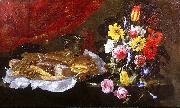 |
Giuseppe Recco -- Click Here
|
|
(1634 - 29 May 1695) was a still life Italian painter.
Born in Naples, he likely apprenticed with his family, including his father Giacomo Recco and uncle Giovan Battista Recco. His children both son Nicolo and daughter Elena were also painters. A large part of his output was painted in Spain, where his assemblies of victuals, both vegetable and animal, were popular. It is claimed he was influenced by the neapolitan Giovanni Battista Ruoppolo.
Recco died at Alicante, Spain. |
|
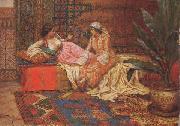 |
Giulio Rosati -- Click Here
|
|
Italian Painter, 1858-1917 |
|
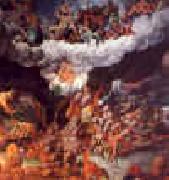 |
Giulio Romano -- Click Here
|
|
Italian
1492-1546
Giulio Romano was born in Rome. In his native city, as a young assistant in Raphael's studio, he worked on the frescos in the Vatican loggias to designs by Raphael and in Raphael's Stanze in the Vatican painted a group of figures in the Fire in the Borgo (L'incendio di Borgo) fresco. He also collaborated on the decoration of the ceiling of the Villa Farnesina. After the death of Raphael in 1520, he helped complete the Vatican frescoes of the life of Constantine as well as Raphael's Coronation of the Virgin and the Transfiguration in the Vatican. In Rome, Giulio decorated the Villa Madama for Cardinal Giuliano de' Medici, afterwards Clement VII. The crowded Giulio Romano frescoes lack the stately and serene simplicity of his master.
In the Palazzo Te, MantuaAfter the Sack of Rome in 1527 and the death of Leo X, artistic patronage in Rome slackened. Vasari tells how Baldassare Castiglione was delegated by Federico Gonzaga to procure Giulio to execute paintings and architectural and engineering projects for the duchy of Mantua. His masterpiece of architecture and fresco painting in that city is the suburban Palazzo Te, with its famous illusionistic frescos (c. 1525?C1535). He also helped rebuild the ducal palace in Mantua, reconstructed the cathedral, and designed the nearby Church of San Benedetto. Sections of Mantua that had been flood-prone were refurbished under Giulio's direction, and the duke's patronage and friendship never faltered: Giulio's annual income amounted to more than 1000 ducats. His studio became a popular school of art. |
|
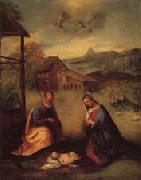 |
Girolamo Romanino -- Click Here
|
|
Italian High Renaissance Painter, 1484-1562 |
|
|
|
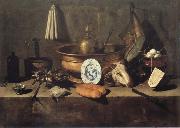 |
Giovanni Battista Recco -- Click Here
|
|
Italian, 1615-1660 |
|
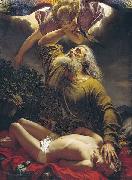 |
Gerhard Wilhelm von Reutern -- Click Here
|
|
painted Abraham sacrificing Isaac in 1849 |
|
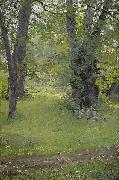 |
Gerda Roosval-Kallstenius -- Click Here
|
|
painted Park with sitting man and dog in 1890 |
|
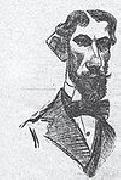 |
Georgios Roilos -- Click Here
|
|
1867 - 1927.
The Homeric Phthia of the Mycenaean period, capital of the Kingdom of the Myrmidons and of Peleus, father of Achilles, has sometimes been identified with the later city of Farsalos, now Pharsala. A Cyclopean Wall which protected a city still exists today near modern Pharsala, as does a vaulted tomb from that period. |
|
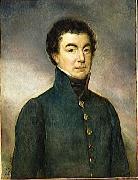 |
Georges Rouget -- Click Here
|
|
Georges Rouget (1781, Paris - 1869, Paris) was a neoclassical French painter.
After studying in the ? - ole des beaux-arts, Rouget entered David's studio in 1797 and rapidly became his favourite student. Rouget began his professional career as his master's main assistant until David's exile to Brussels, collaborating with him on the canvases Bonaparte at the Grand-Saint-Bernard, The Coronation of Napoleon (of which he made a copy signed by David), Leonidas at Thermopylae and on one of the three copies of the Portrait of Pope Pius VII. Though winning the second prize in the prix de Rome contest in 1803, he failed three times to win the first prize. He produced many canvases for the First French Empire and the Bonapartes, such as The Marriage of Napoleon and Marie Louise in 1811. A minor painter, he spent his whole career producing paintings of great moments in French history for whatever regime was in power at the time. Many of his paintings adorned the musee de Versailles opened by Louis-Philippe in 1837. |
|
|
|
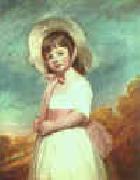 |
George Romney -- Click Here
|
|
1734-1802
George Romney Galleries
By 1757 he was becoming well-known as a portraitist. He fell ill during his apprenticeship and was nursed back to health by Mary Abbott, daughter of his landlady.
In 1762, by which time he was married with two children, he went to London, and saw early success with a painting, The Death of General Wolfe which won a prize from the Royal Society of Arts. Romney soon had a thriving portrait business in Long Acre.
Despite his great success George Romney was never invited to join the Royal Academy nor did he ever apply to join. While there has been much speculation about his relationship with the Academy there is no doubt that he normally remained aloof maintaining that a good artist should succeed without being a member. His own career certainly supported this belief and it was only towards the end of his life that he expressed the slightest regret for his views
Portrait of Miss Juliana Willoughby, 1781-83 (National Gallery of Art, Washington DC)
Emma Hamilton as a bacchante by George Romney, 1785In 1773 he travelled to Italy with fellow artist Ozias Humphrey to study art in Rome and Parma, returning to London in 1775 to resume business, this time in Cavendish Square (in a house formerly owned by noted portraitist Francis Cotes). In 1782 he met Emma Hamilton (then called Emma Hart) who became his muse. He painted over 60 portraits of her in various poses, sometimes playing the part of historical or mythological figures. He also painted many other contemporaries, including fellow artist Mary Moser. After an absence of almost forty years, he returned to his family in Kendal in the summer of 1799. He was greeted by his loyal, devoted and unquestioning wife. George Romney is a kinsman of Mitt Romney, U.S politician. |
|
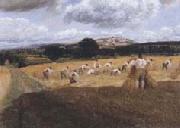 |
George Robert Lewis -- Click Here
|
|
English, 1782-1871 |
|
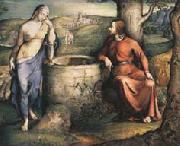 |
George Richmond -- Click Here
|
|
English Painter, 1809-1896
Painter, draughtsman and engraver. He was a precocious draughtsman. In 1824 he entered the Royal Academy, London, the same year as Edward Calvert, who was a part-time student of Joseph Severn. Richmond first exhibited at the Academy in 1825 and that year met William Blake in the Highgate house of John Linnell (ii). Like his lifelong friend Samuel Palmer, Richmond fell under Blake's spell, comparing him to the Prophet Isaiah and forming close friendships with Blake's other disciples, including Calvert. He visited Palmer at Shoreham, chiefly in the summer of 1827, and both he and Calvert became prominent members of Palmer's band of ANCIENTS, who frequented the Kent village in the late 1820s and early 1830s. The tempera panel Abel the Shepherd (1826; London, Tate) is typical of Richmond's early paintings, which reflect the pronounced influence of both Blake and Palmer. They are painted in an archaic style and include Christian and literary themes and high-minded if obscure genre subjects such as the Eve of Separation (1830; Oxford, Ashmolean). The human figure was central to these pictures as it was not for Palmer, who expressed sentiment through landscape motifs. Richmond was also active as a draughtsman and miniaturist during this period; his Christ-like head of Palmer, in watercolour and gouache on vellum (London, N.P.G.), dates from 1829. |
|
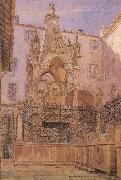 |
George Price Boyce,RWS -- Click Here
|
|
1826-1897
English painter. He was the son of a prosperous wine merchant and pawnbroker. His childhood was spent in London, and in 1846 he was apprenticed to the firm of architects Wyatt & Brandon, where he remained for three years. He was always fascinated by ancient buildings but gradually lost interest in architecture as a career. In 1849, perhaps as a result of meeting David Cox at Betws-y-Coed (Gwynedd, Wales), he decided to become a painter. In the early 1850s Boyce drew landscape and architectural subjects with a fluent watercolour technique derived from Cox. In 1854 Boyce made an extended journey to Italy; he painted views of buildings in Venice and Verona |
|
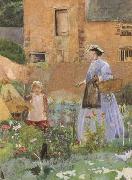 |
George John Pinwell,RWS -- Click Here
|
|
1842-1875
English illustrator and painter. He was born in humble circumstances and was largely untrained. He was briefly a student at St Martin's Lane Art School and at Heatherley's. From 1863 he contributed woodblock illustrations to magazines, establishing his reputation in 1865 with the Dalziel brothers' editions of The Arabian Nights and The Works of Oliver Goldsmith. Pinwell's finest drawings were commissioned for the Dalziels' poetry gift-books. With another illustrator, John William North (1842-1924), he worked at Halsway Manor in Somerset in 1865, experimenting with formal effects based on the structure of stone farm buildings or on the wooden beams of barn interiors (his drawings do not seem to have survived). Some of the illustrations for A Round of Days (1866) and Wayside Posies (1867) present an ideal vision of the countryside, but a vein of social concern is also present. In The Journey's End, from Wayside Posies, a strolling player lies dead, worn out by hardship and hunger. For an illustrated edition of Jean Ingelow's Poems (1867), |
|
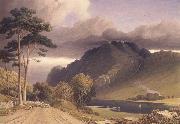 |
George Fennel Robson -- Click Here
|
|
English Painter, 1788-1833
English watercolourist. After initial training in Durham, Robson moved to London in 1804 with the intention of becoming a landscape painter. He was introduced to the circle of artists surrounding John Varley, and it was from Varley that Robson derived the strong, uncluttered compositions and breadth of manner that characterize his own style. |
|
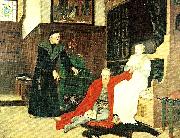 |
georg von rosen -- Click Here
|
|
Johan Georg Otto von Rosen, född 13 februari 1843 i Paris, död 1923 i Stockholm, var en svensk konstnär och greve av ätten von Rosen. Han målade i den akademiska stilen, till stor del historiemåleri och porträtt. Han var professor vid Konstakademien 1880-1908 och dess direktör 1881-1887 samt 1893-1899. Som konstakademiens direktör kom han i stark konflikt med den nya generation av konstnärer som krävde reformer av akademiens utbildning och utställningsverksamhet, de så kallade opponenterna.
Georg von Rosen föddes i Paris 1843 som son till generalkonsuln greve Adolf Eugene von Rosen (kallad "de svenska järnvägarnas fader") och hans hustru Euphrosyne Rizo-Rangabe. Hans första levnadsår förflöt i Paris, varifrån familjen flydde till Sverige under februarirevolutionen 1848. Han studerade 1855-1861 vid Konstakademien i Stockholm. 1862 besökte Rosen världsutställningen i London där han lärde känna belgaren Henri Leys' arbeten, målningar med scener från medeltiden och renässansen målade i ålderdomlig stil. Dessa verk gjorde ett stort intryck på von Rosen. Han skrev själv
Stående hvarje dag i flere timmar, försjunken i åskådandet af dessa om en snart sagdt öfvermänsklig intuition vittnande bilder, som likväl flertalet i den stora hopen med likgiltighet skred förbi, drömde jag mig tillbaka in i en hänsvunnen tid och för mina yttre ögon försvann hela den öfriga utställningen, den omgifvande mängden, ja hela den existerande verlden! Då jag lemnade London, var jag på 14 dagar vorden 300 år äldre.
Rosen uppsökte följande året mästaren i Antwerpen och tillbringade en tid i hans umgänge och i hans atelje. Återkommen till Sverige, inspirerad av mötet, målade han Sten Sture d.ä. intåg i Stockholm. Den medeltida stadsmiljön med det noggranna återgivandet av stenläggningen och den närmast osannolika rikedomen på byggnadsdetaljer känns igen från Leys målningar. von Rosen belönades med kunglig medalj för målningen, och blev hyllad och uppskattad av Oscar II på grund av bildspråket, som i hög grad uttryckte den oscarianska epokens ideal. Samma år begav han sig ut på resa och besökte Egypten, Palestina, Syrien, Osmanska riket, Grekland och Ungern där han studerade måleri. 1866 vistades han ett år i Rom och vistades sedan åter hos Leys fram till dennes död 1869. Därefter studerade han i Menchen under Karl Piloty och reste sedan vidare till Italien innan han återkom till Sverige 1871. Efter hemkomsten målade han Erik XIV och Karin Månsdotter.
1872 blev han ledamot av Konstakademien, 1874 blev han vice professor, 1879 kammarherre och 1880 professor i figurteckning och målning. 1881-1887 samt 1893-1899 var han direktör för Akademins läroverk. 1892-1900 var han även ordförande i Nordiska samfundet till bekämpande av det vetenskapliga djurplågeriet, numera Djurens Rätt.
Han avled 1923 och förblev ogift under hela sitt liv. |
|
 |
Georg Anton Rasmussen -- Click Here
|
|
1842-1914
paint Norsk fjordlandskap |
|
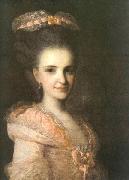 |
Fyodor Rokotov -- Click Here
|
|
(1736 - 1809) was a distinguished Russian painter who specialized in portraits.
Fyodor Rokotov was born into a family of peasant serfs, belonging to the Repnins. Much in his biography is obscure. He studied art in Saint Petersburg Academy of Arts. After buying back his freedom in the end of 1750s he became established as a fashionable painter.
In 1765, Rokotov was elected an Academician, but he did not work as a professor in the Academy long, because it interfered with his painting. He returned to Moscow in 1765, where he lived for the rest of his life. He had a lot of commissions there, becoming one of the best portrait painters of his time.
Among his best-known portraits are Portrait of Alexandra Struyskaya (1772), sometimes called the Russian Mona Lisa and admittedly the most celebrated piece of the 18th-century Russian painting; Portrait of Countess Elisabeth Santi (1785), and Lady in a Pink Dress. |
|
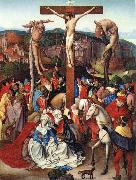 |
FRUEAUF, Rueland the Younger -- Click Here
|
|
Austrian painter (b. ca. 1470, Passau, d. ca.
1545, Passau). |
|
 |
FRUEAUF, Rueland the Elder -- Click Here
|
|
Austrian painter (b. 1440/45, Passau, d. 1507, Passau).
|
|
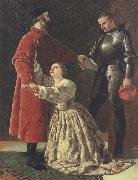 |
Frederick richard pickersgill,R.A. -- Click Here
|
|
1820-1900
was an English painter and book illustrator. Born into a family of artists, he was admitted to the Royal Academy Schools in 1840. He did some book illustrations for the works of John Milton and Edgar Allan Poe. Pickersgill's The Burial of Harold was accepted as a decoration for the Houses of Parliament in 1847. He also did some landscapes under the influence of the Pre-Raphaelites. In 1856 Pickersgill was photographed at 'The Photographed Institute' by Robert Howlett, as part of a series of portraits of 'fine artists'. |
|
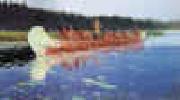 |
Frederick Remington -- Click Here
|
|
1861-1909
Frederic Sackrider Remington (October 4, 1861 - December 26, 1909) was an American painter, illustrator, sculptor, and writer who specialized in depictions of the Old American West, specifically concentrating on the last quarter of the 19th century American West and images of cowboys, American Indians, and the U.S. Cavalry.
Remington was the most successful Western illustrator in the ??Golden Age?? of illustration at the end of the 19th Century and the beginning of the 20th Century, so much so that the other Western artists such as Charles Russell and Charles Schreyvogel were known during Remington??s life as members of the ??School of Remington??. His style was naturalistic, sometimes impressionistic, and usually veered away from the ethnographic realism of earlier Western artists such as George Catlin. His focus was firmly on the people and animals of the West, with landscape usually of secondary importance, unlike the members and descendants of the Hudson River School, such as Frederic Edwin Church, Albert Bierstadt, and Thomas Moran, who glorified the vastness of the West and the dominance of nature over man. He took artistic liberties in his depictions of human action, and for the sake of his readers?? and publishers?? interest. Though always confident in his subject matter, Remington was less sure about his colors, and critics often harped on his palette, but his lack of confidence drove him to experiment and produce a great variety of effects, some very true to nature and some imagined.
His collaboration with Owen Wister on The Evolution of the Cowpuncher, published by Harper??s Monthly in September 1893, was the first statement of the mythical cowboy in American literature, spawning the entire genre of Western fiction, films, and theater that followed. Remington provided the concept of the project, its factual content, and its illustrations and Wister supplied the stories, sometimes altering Remington??s ideas. (Remington??s prototype cowboys were Mexican rancheros but Wister made the American cowboys descendants of Saxons??in truth, they were both partially right, as the first American cowboys were both the ranchers who tended the cattle and horses of the American Revolutionary army on Long Island and the Mexicans who ranched in the Arizona and California territories). |
|
 |
Frederick goodall,R.A. -- Click Here
|
|
1822-1904
son of Edward Goodall. He was taught by his father and first exhibited at the Royal Academy in 1838. His earliest subjects were rural genre scenes and landscapes, many derived from sketching trips made between 1838 and 1857 in Normandy, Brittany, Wales, Ireland, Scotland and Venice. In the 1850s he also painted subjects from British history. More significant for his subsequent career was his visit to Egypt from September 1858 to April 1859. In Cairo he lived in a house in the Coptic quarter with Carl Haag. Together the two artists went on expeditions to Giza to draw the Nile, the Sphinx and Pyramids, and to Suez and across the Red Sea to the Wells of Moses at 'Uyen Mesa. Goodall also made rapid sketches in the crowded streets of Cairo. 'My sole object in paying my first visit to Egypt', he wrote, 'was to paint Scriptural subjects'. The first of these, Early Morning in the Wilderness of Shur (London, Guildhall A.G.), was exhibited at the Royal Academy in 1860 and won him critical and popular acclaim. In 1864 he was elected RA. Much of the rest of Goodall's long career was devoted to painting similar scenes of Egyptian life with biblical associations, for which he made reference to his sketches and to Egyptian artefacts and clothing. Their success prompted a second visit to Egypt in 1870-71. |
|
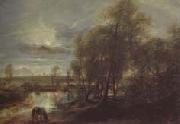 |
Frederic Remington -- Click Here
|
|
American Painter and Sculptor, 1861-1909
American painter, sculptor, illustrator and writer. In 1878 he began his studies at the newly formed School of the Fine Arts at Yale University in New Haven, CT, remaining there until 1880. This, along with a few months at the Art Students League in New York in 1886, was his only period of formal art training. In 1881 he roamed through the Dakotas, Montana, the Arizona Territory and Texas to document an era that was fast vanishing. He returned east and in 1882 had his first drawing published (25 Feb) in Harper's Weekly. Further commissions for illustrations followed, including that for Theodore Roosevelt's Ranch Life and the Hunting Trail (New York, 1888) (see BOOK ILLUSTRATION, fig. 8). |
|
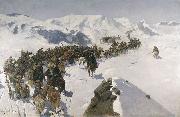 |
Franz Roubaud -- Click Here
|
|
was a Russian painter who created some of the largest and best known panoramic paintings.
Roubaud was born on 15 June 1856 in Odessa and attended an art school there. In 1877 he went to Munich, where he studied at the Munich Academy. He then settled in Saint Petersburg, working in the Imperial Academy of Arts and painting huge panorams of historical battles - Storm of Achulgo (1896, Tiflis, now under the restoration in the museun of graphic arts in Makhachkala), Siege of Sevastopol (1854) (unveiled in 1905, damaged during the Siege of Sevastopol (1942), restored in the 1950s), Battle of Borodino (1911, moved to Poklonnaya Hill in Moscow in 1962) and the Russo-Persian War (1804-1813). His works were so large that they had to be exhibited in pavilions specially built for that purpose. In 1913, Roubaud left Russia for Munich, where he died on 13 March 1928.
|
|
|
|
|
|
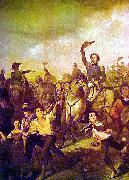 |
Francois-Rene Moreaux -- Click Here
|
|
painted Announcement of Independence in 1844 |
|
|
|
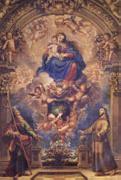 |
Francisco Rizi -- Click Here
|
|
Spanish painter, 1614-1685 |
|
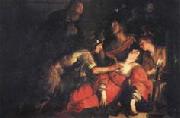 |
Francesco Rustici -- Click Here
|
|
Italian High Renaissance Sculptor, 1474-1554 |
|
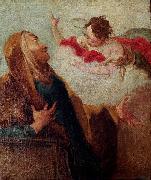 |
Francesco Maria Raineri -- Click Here
|
|
(February 2, 1676 - February 28, 1758) was an Italian painter of the late-Baroque, mainly active in Mantua.
Also called Lo Schivenoglia after the town, just outside of the city of Mantua, of his birth. He was a pupil of Giovanni Canti. Among his works, he was known for his paintings of battle scenes, landscapes, and cappriccios (vedute of imaginary scenes) with historical or mythologic figures. He was named director of the Academy of painters in Mantua in 1752. He is known to have painted a St. Sebastian for the chapel of Santa Anna. |
|
|
|
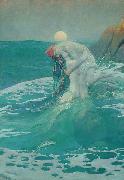 |
Floris Arntzenius -- Click Here
|
|
(9 June 1864 - 16 February 1925) was a Dutch painter, water-colourist, illustrator and printmaker. He is considered a representative of the younger generation of the Hague School.
Arntzenius was born in Surabaya on the island of Java where his father served in the Royal Dutch East Indies Army. In 1875, at the age of 11, he was sent to the Netherlands to Amsterdam to live with his aunt and uncle in order to complete his education.
In 1882 he became a student of Frederik Nachtweh, under Nachtweh's supervision he gained admission to the Rijksacademie van Beeldende Kunsten. During his time at the Rijksacademie, from 1883 to 1888, his teachers included August Allebe and Barend Wijnveld, and amongst his fellow students were Isaac Israëls, George Breitner, Willem Witsen and Jan Veth. After his studies in Amsterdam he spent another two years at the Koninklijke Academie voor Schone Kunsten in Antwerp, studying under Charles Verlat.
Back in Amsterdam, Arntzenuis became a member of the artist's societies Arte et Amicitiae (1890) and St. Lucas (1891), and he had a studio at the Sarphatistraat. In 1892 his mother became widowed and moved to The Hague and Arntzenuis also moved there to keep her company. Around the same time his former fellow students Isaac Israëls and George Breitner left The Hague for Amsterdam to be a part of the capital's more vibrant artistic climate. At The Hague the established painters of the first generation of the Hague School dominated artistic life.
Spuistraat, 1919, Haags Historisch MuseumArntzenius became a member of the artist's society Pulchri Studio in The Hague in 1892. From 1893 to 1895 he shared Bernard Blommers' former studio with Cornelis Antonie van Waning. He also contributed illustrations to Elsevier Geïllustreerd Maandschrift from 1892 to 1894. In 1896 he was admitted to the Hollandsche Teeken Maatschappij, a society that promoted the medium of watercolours among its members. He got married in 1900, to Lide Doorman, a talented painter of floral still lives, who lived in the house opposite of Arntzenius' mother, together they had four daughters, who he frequently painted.
|
|
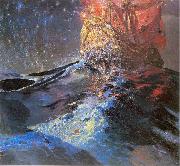 |
Ferdynand Ruszczyc -- Click Here
|
|
(1870-1936) was a Polish painter, printmaker, and stage designer. Ruszczyc originally studied law at the University of St. Petersburg, but then switched majors and began taking painting classes at the Academy of Fine Art. He was a student of famous Russian landscape painters Ivan Shishkin and Arkhip Kuindzhi. Ruszczyc travelled to the Crimea to paint seascapes, and later to the Baltic islands and Sweden to paint northern landscapes. He visited Berlin, where he was significantly influenced by the Symbolist painters such as Arnold Bocklin. After graduation, Ruszczyc made extensive tours of Western Europe incorporating much of the styles he came across into his own art. |
|
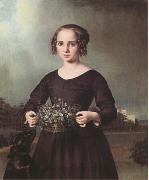 |
Ferdinand von Rayski -- Click Here
|
|
1806-1890
was a German painter noted for his portraits. Rayski was born in 1806 in Pegau. From 1816 to 1821 he studied drawing under Traugott Faber at the Freimaurerinstitut in Dresden and from 1823 to 1825 studied at Kunstakademie in Dusseldorf. He began his career as a professional artist in 1829, painting portraits of his noble relatives in Hannover and Silesia. From 1831 to 1834 he lived in Dresden, where he received numerous portrait commissions. He traveled to Paris in 1834-35, and was influenced by the works of Delacroix, Gericault and Gros. Rayski gained a reputation as a distinguished portrait painter, but also produced animal and hunting scenes, as well as, yet less frequently, military, historical and mythological paintings. |
|
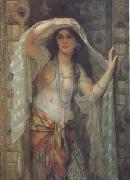 |
Ferdinand Roybet -- Click Here
|
|
1840-1920
French painter. Although he studied engraving at the Ecole des Beaux-Arts in Lyon, he very early devoted himself exclusively to painting. In 1864 he settled in Paris, where his lyrical, zestful canvases, for example a Jester at the Court of Henry III , quickly met with success. They chiefly show characters in medieval or Renaissance costume in attitudes of studied ease. Critics noted his strong colours and firm brushwork, regretting only that his shadows seemed too sooty. |
|
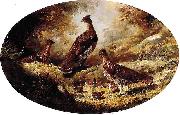 |
Ferdinand Richardt -- Click Here
|
|
(10 April 1819 - 29 October 1895) Danish-American artist, in Denmark known for his lithographs of manor houses, and in the U.S. for his paintings of Niagara Falls and other landscapes.
Ferdinand Richardt, the son of Johan Joachim Richardt and Johanne Frederikke ne Bohse, was born in Brede, north of Copenhagen in 1819. His father ran the inn/company store at the Brede factory. In 1832 the family relocated to nearby Ørholm to operate the inn at the paper-factory there. In 1839, they moved to Copenhagen.
Ferdinand became briefly a carpenter's apprentice in 1835, but soon decided on a career in fine art, following the lead of his brother Carl. Beginning in 1836 Ferdinand studied at the Royal Danish Academy of Art under the architect and designer Gustav Friedrich Hetsch, the historical painter J. L. Lund and the classical sculptor Bertel Thorvaldsen. Richardt was awarded the Academy's small and large silver medals in 1839 and 1840, respectively.
In 1847, he received a five year stipend from the crown, on the condition that he deliver one architectural and one landscape painting each year to the royal collection. Between 1855 and 1859 he visited in the United States. He maintained a studio in New York City, while traveling during the summers to Niagara Falls and to various destinations east of the Mississippi River.
After returning to Denmark, Richardt married the widow Sophia Schneider ne Linnemann (1831-1888) in 1862. They traveled for part of a year in southern Europe, and from 1863 they lived for a period in England. In February 1864, Queen Victoria invited Richardt to display his art work to the court at Windsor Castle.
In 1872 and 1873, Richardt sold many of his accumulated paintings and lithographs before emigrating to the United States with his family. They lived first in the town of Niagara Falls, N.Y. where the artist again produced canvases depicting the great waterfall and the surrounding area. In 1875, the Richardts moved to San Francisco, and finally in 1876 to Oakland. For the remaining twenty years of his life Richardt was active as a painter of California landscapes with a concentration on the San Francisco Bay Area. He exhibited and sold his works in San Francisco until at least 1887. At the same time he taught drawing privately. At his death in 1895, Richardt left a daughter, Johanna (1862-1897), and a stepson, Joost Schneider.
|
|
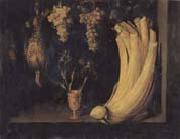 |
Felipe Ramirez -- Click Here
|
|
Spanish painter (documented 1628-1631 in Toledo). |
|
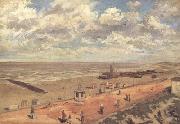 |
Felicien Rops -- Click Here
|
|
Belgian Symbolist Engraver, 1833-1898
was a Belgian artist, and printmaker in etching and aquatint. Rops was born in Namur in 1833, and was educated at the University of Brussels. Rops's forte was drawing more than painting in oils; he first won fame as a caricaturist. He met Charles Baudelaire towards the end of Baudelaire's life in 1864, and Baudelaire left an impression upon him that lasted until the end of his days. Rops created the frontispiece for Baudelaire's Les Épaves, a selection of poems from Les Fleurs du mal that had been censored in France, and which therefore were published in Belgium. Rops's association with Baudelaire and with the art he represented won his work the admiration of many other writers, including Theophile Gautier, Alfred de Musset, St phane Mallarm, Jules Barbey d'Aurevilly, and Josephin Peladan. He was closely associated with the literary movement of Symbolism and Decadence. Like the works of the authors whose poetry he illustrated, his work tends to mingle sex, death, and Satanic images. |
|
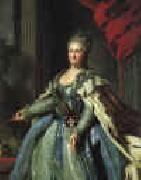 |
Fedor Rokotov -- Click Here
|
|
Russian Painter, ca.1735-1808
Fyodor Stepanovich Rokotov (Fedor Rokotov) (Russian: ?????????? ??????????́?????????? ????́??????????) (1736?C1809) was a distinguished Russian painter who specialized in portraits.
Fyodor Rokotov was born into a family of peasant serfs, belonging to the Repnins. Much in his biography is obscure. He studied art in Saint Petersburg Academy of Arts. After buying back his freedom in the end of 1750s he became established as a fashionable painter.
In 1765, Rokotov was elected an Academician, but he did not work as a professor in the Academy long, because it interfered with his painting. He returned to Moscow in 1765, where he lived for the rest of his life. He had a lot of commissions there, becoming one of the best portrait painters of his time.
Among his best-known portraits are Portrait of Alexandra Struyskaya (1772), sometimes called the Russian Mona Lisa and admittedly the most celebrated piece of the 18th-century Russian painting; Portrait of Countess Elisabeth Santi (1785), and Lady in a Pink Dress (1770s, illustration, right).
Rokotov avoided painting formal portraits with lots of adornments and decorations. Instead he was one of the first Russian painters advancing a psychological portrait with attention to optical and atmospheric effects. |
|
|
|
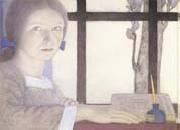 |
F. Cayley Robinson -- Click Here
|
|
British Painter and Illustrator, 1862-1927 |
|
|
|
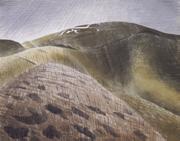 |
Eric Ravilious -- Click Here
|
|
British Painter, ca.1903-1942
English painter, wood-engraver and designer. He was educated at Eastbourne School of Art and then at the Royal College of Art (1922-5), where he was taught by Paul Nash and became close friends with Edward Bawden. His early works included the refectory mural (destr. 1940) in Morley College, London, and wood-engravings in the tradition of Bewick for the Golden Cockerel, Curwen and Nonesuch presses. In the 1930s he began painting larger compositions in a wider range of colour, and this led him to use lithography for such illustrations as those for High Street. Ravilious also produced designs for Wedgwood, including the celebration mug (1936) for the coronation of King Edward VIII, which was withdrawn and revised for the coronations of George VI and Elizabeth II; the Alphabet mug (1937); the Afternoon Tea (1937), Travel (1938) and Garden Implements (1939) china sets; and the Boat Race Day cup (1938). He also designed glass for Stuart Crystal (1934), furniture for Dunbar Hay (1936) and graphic work for advertisements for London Transport and others. Despite his success as a designer, Ravilious concentrated increasingly on watercolours. His landscapes and rural interiors often featured the downland and coast of southern England; haunting and lyrical, these works show a world in suspense and often feature chalk hill figures, as in Train Landscape (c. 1939; Aberdeen, A.G.) and empty rooms. |
|
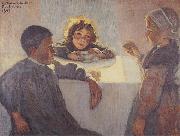 |
Eric Forbes-Robertson -- Click Here
|
|
(1865-1935).
a figure and landscape painter
a figure and landscape painter.was a Scottish painter of landscapes, flowers, and foliage, with children. He was a cousin of James Hornell. He was born in Australia, of Scottish parents, and he was brought up and lived practically all his life in Scotland, at Kirkcudbright. He studied for three years at the art school at Edinburgh, and for two years at Antwerp under Professor Verlat. Returning from Antwerp in 1885, he met George Henry and associated himself with the Glasgow School. Hornel and Henry collaborated upon "The Druids Bringing In The Mistletoe" (1890), a procession of priests bringing in the sacred mistletoe, gorgeous with polychrome and gold. The two worked side by side to achieve decorative splendor of color, Hornel boldly and freely employing texture effects produced by loading and scraping, roughening, smoothing, and staining. In 1893-94 the two artists spent a year and a half in Japan, where Hornel learned much about decorative design and spacing. Towards the close of the nineties his colors, while preserving their glow and richness, became more refined and more atmospheric, and his drawing more naturalistic, combining sensuous appeal with emotional and poetic significance. In 1901 he declined election to the Royal Scottish Academy. In 1901 he acquired Broughton House, a townhouse and garden in Kirkcudbright, which was his main residence for the rest of his life. |
|
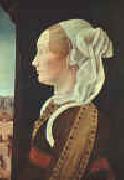 |
Ercole Roberti -- Click Here
|
|
1456-1496
Italian
Ercole Roberti Gallery
Ercole de' Roberti (c. 1451 ?C 1496), also known as Ercole Ferrarese or Ercole da Ferrara, was an Italian artist of the Early Renaissance and the School of Ferrara. He was profiled in Vasari's Le Vite delle pi?? eccellenti pittori, scultori, ed architettori.
The son of the doorkeeper at the Este castle, Ercole later held the position of court artist for the Este family in Ferrara. According to Vasari:
By 1473, when he was 17, Ercole had left Ferrara and was working in Bologna in the studio of Francesco del Cossa. (According to Vasari, Ercole also apprenticed under Lorenzo Costa in Bologna, but this seems unlikely as he was Lorenzo's senior by seveal years). He is known to have collaborated in the frescoes of Palazzo Schifanoia.
Ercole's first mature works are his contributions to the Griffoni Chapel for the San Petronio Basilica in Bologna: a predella depicting the Miracles of St Vincent Ferrer (c.1473) (now in the Pinacoteca of the Vatican), and lateral pilasters for the altarpiece commissioned from del Cossa.
In 1480, Ercole created a large altarpiece with a Madonna and Child Enthroned with Saints for Santa Maria in Porto in Ravenna, which is now in the Brera, Milan. Portraits of Giovanni II Bentivoglio and Ginevra Bentivoglio attributed to Ercole de' Roberti (c. 1480) are in the National Gallery of Art, Washington, D.C.
Ercole succeeded Cosm?? Tura as court painter to the Este family in Ferrara around 1486. His role apparently went far beyond making art: he accompanied Alfonso d'Este on a papal visit to Rome, served as wardrobe manager for Isabella d'Este's wedding in Mantua, and may even have made salamis.
A painting of Portia and Brutus (c. 1486-90), believed to be painted for Eleonora of Aragon, duchess of Ferrara, is in the Kimbell Art Museum, Fort Worth, Texas. Ercole's painting of Saint Jerome in the Wilderness from this period is in the collection of the J. Paul Getty Museum, Los Angeles. |
|
 |
Ercole de Roberti -- Click Here
|
|
Ferrara ca 1451/56-1496
was an Italian artist of the Early Renaissance and the School of Ferrara. He was profiled in Vasari's Le Vite delle pi?? eccellenti pittori, scultori, ed architettori. The son of the doorkeeper at the Este castle, Ercole later held the position of court artist for the Este family in Ferrara. According to Vasari: Ercole had an extraordinary love of wine, and his frequent drunkenness did much to shorten his life, which he had enjoyed without any accident up to the age of forty, when he was smitten one day by apoplexy, which made an end of him in a short time. Paintings by Ercole are rare. |
|
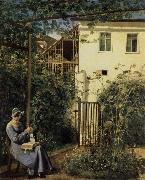 |
Erasmus Ritter von Engert -- Click Here
|
|
Austrian, 1796-1871 |
|
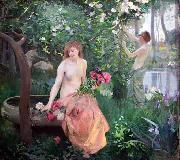 |
emile-Rene Menard -- Click Here
|
|
(1861 - 1930) was a French painter born in Paris. From early childhood he was immersed in an artistic environment: Corot, Millet and the Barbizon painters frequented his family home, familiarizing him thus with both landscape and antique subjects.
Menard studied at the Academy Jullian from 1880 after having been a student of Baudry, Bouguereau, and Henri Lehmann. He participated in the Salon of the Secession in Munich, and the Salon de la Libre Esthetique in Brussels during 1897. Several personal exhibitions were also devoted to him at the Georges Small Gallery. In 1921 he exhibited in the Twelfth Salon along with Henri Martin and Edmond Aman-Jean. Galleries in Buffalo, New York and Boston, Massachusetts exposed Menard and his art to the United States. However, the numerous commissions that Menard received from the French government crowned his career; for example, the cycle for the Hautes Etudes e la Sorbonne, the Faculte de Droit, and the fresco Atoms for the Chemistry institute, and finally the Caise des Depôts in Marseilles.
Menard's art allies a rigorous, clear classicism with a diffuse and dreamlike brushwork. In 1894, Victor Shoe wrote of Menard in l' Art et la Vie (Art and Life): "visions of a pacified, bathed nature, of dawn and of twilight, where the soul seems to immerse itself in the innocence of daybreak, and breathe the divine anointment that comes with the dawn."
|
|
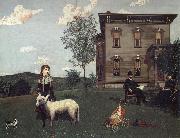 |
Elmer Edwin Romanzo -- Click Here
|
|
Portrait, genre and still life painter
b.1850 d.1923
was an American portrait, genre and still life painter. Known for his attention to detail, he was also an inventor of a machine for braiding horsewhips. Spending most of his life in Ashfield, Massachusetts, Elmer is best known for his painting Mourning Picture. This 1890 family portrait depicts the artist, his wife, and their daughter Effie who had died shortly before it was painted. The painting is noted for its intricate detail and the contrast between the mourning family, who sits in relative darkness, and the dead daughter, who is bathed in sunlight. It was first displayed in a local post office in 1890, then disappeared until the 1950's. |
|
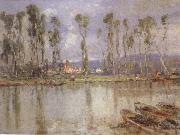 |
Eliseo Meifren y Roig -- Click Here
|
|
Spanish, 1859-1940 |
|
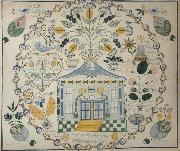 |
Eldress Polly Jane Reed -- Click Here
|
|
b.1818 d.1881
|
|
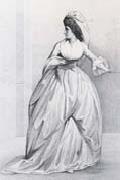 |
Edwin Roffe -- Click Here
|
|
British,fl.Mid-nineteenth century |
|
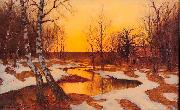 |
Edward Rosenberg -- Click Here
|
|
painted Solnedgang i vinterlandskap in 1921
Edward Rosenberg (1858-1934)Aliases: Axel Edvard John Rosenberg; Axel Edward John Rosenberg; Edvard RosenbergProfessions: Landscape painter. |
|
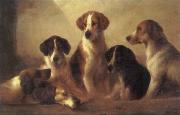 |
Edward Robert Smythe -- Click Here
|
|
British
1810-1899
|
|
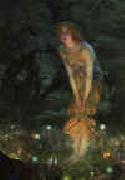 |
Edward Robert Hughes -- Click Here
|
|
British
1851-1917
Edward Robert Hughes (1851-1917) is a well known English painter who worked in a style influenced by Pre-Raphaelitism and Aestheticism. Some of his best known works are Midsummer Eve and Night With Her Train of Stars. Hughes was the nephew of Arthur Hughes. He often used watercolour/gouache. He was elected ARWS in 1891 and chose as his diploma work for election to full membership a mystical piece inspired by a verse by Christina Rossetti's "Amor Mundi". Technically Hughes experimented with ambitious techniques. He was a perfectionist who did numerous studies which in their own right turned out to be good enough for exhibition
He was also an assistant to the elderly William Holman Hunt. He helped the increasingly infirm Hunt with the version of The Light of the World now in St. Paul's Cathedral and with The Lady of Shalott. He died on April 23 1914 at his cottage in St. Albans, Hertfordshire.
|
|
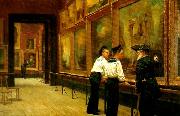 |
edward r taylor -- Click Here
|
|
Edward Richard Taylor RBSA (June 14, 1838 - January 11, 1911) was an English artist and educator. He painted in both oils and watercolours.
Taylor taught at the Lincoln School of Art and became influential in the Arts and Crafts movement as the first headmaster at the Birmingham Municipal School of Arts and Crafts from 1877-1903.
In December 1898, he founded Ruskin Pottery at Smethwick, Staffordshire. His son William Howson Taylor (1876 -1935) took over Ruskin Pottery after the death of his father. |
|
|
|
|
|
|
| | |
|
|
|
|